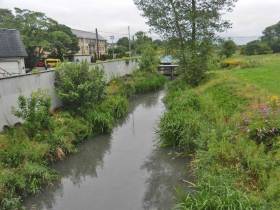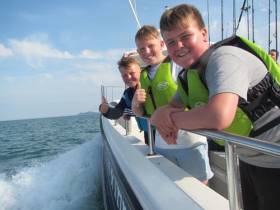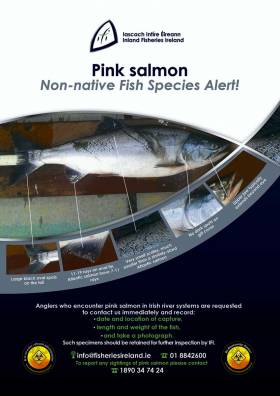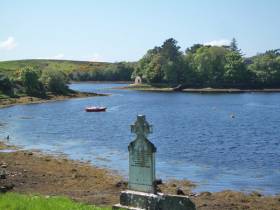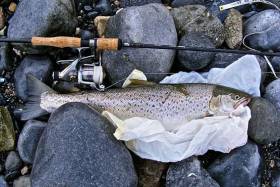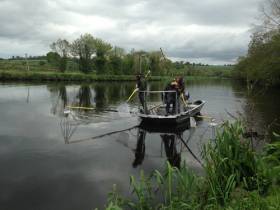Displaying items by tag: Inland Fisheries Ireland
Tolka Fish Kill Caused By Tyre Blocking Sewer
#FishKill - A car tyre blocking a sewer led to a major fish kill on the River Tolka in West Dublin this week.
According to TheJournal.ie, as many as 500 fish were killed over a 3km stretch of the waterway between Mulhuddart and Blanchardstown after the blockage caused a manhole cover to overflow into the river.
Local anglers reported the incident to Inland Fisheries Ireland on Tuesday evening (18 July), as RTÉ News reports.
Since then, local angling shop proprietor Derek Talbot has described it as an “absolute disaster” for West Dublin’s angling community.
The Tolka previously suffered an extensive fish kill almost exactly three years ago, affecting thousands of fish downstream from Finglas Road in Glasnevin.
#Angling - Young people from Darndale and Whitechurch in Dublin were among the first groups to get out fishing as part of the Dublin Angling Initiative’s 2017 summer season.
Sphere 17 Youth Services from Darndale in North Dublin took a Fish & Trips charter boat for a few hours of sea angling.
The group spent the evening learning how to fish beside Lambay Island, catching pollock and mackerel — and while fishing they also reported seeing plenty of local birds and seals, as well as wallabies and deer on the island.
The fishing trip was one of six over the past month with the group also enjoying lessons in coarse and game fishing.
Meanwhile, Southside youth group Whitechurch Youth Services were taken to Courtlough Fisheries in Balbriggan where they were coached in bubble and fly fishing for trout. Participants learned about fish handling and catch and release fishing.
In addition to fishing lessons and field trips, Inland Fisheries Ireland’s Dublin Angling Initiative (DAI) has also been attending community events with a view to introducing young people to the fisheries resource in their own locality.
At the recent Chapelizod Community Festival, 16 young people between the ages of 10 and 15 enjoyed an environmental and history lesson on the River Liffey that runs through their community from fisheries staff.
That was followed by a more practical session of sampling and identifying invertebrates, plus an opportunity to examine juvenile trout and salmon taken from the river before being safely released again, as well as a fly fishing lesson.
“Angling is a hobby that can be enjoyed in an urban location such as Dublin at any age or ability,” said DAI co-ordinator Oisin Cahill. “We hope that the young people who participate in the programme and who are introduced to fishing will continue to enjoy it into later life.”
Anyone interested in learning more about the DAI should contact Oisin Cahill at [email protected] — enquiries are welcome from any groups or individuals interested in the programme, and availability will be on a first come, first served basis.
Inland Fisheries Ireland Seeks New Human Resources Head
#Jobs - Inland Fisheries Ireland (IFI) is seeking a Head of Human Resources to be based at its headquarters in Dublin’s Citywest.
Reporting to the CEO, the successful candidate would be responsible for the management and direction of IFI’s Human Resources Division, for the achievement of functional targets and business objectives, and for the strategic development and management of key areas to support IFI in achieving its strategic corporate goals.
This includes management of its human resource assets, and organisational development/optimisation through the identification and implementation of progressive, people-orientated development policies.
This position requires an enabler of change, who will be responsible for the leadership of the strategic HR function within IFI and the implementation of a diverse range of HR programmes.
IFI is looking for a practical and pragmatic HR practitioner with a track record of influencing and operating at a senior level, delivering a professional, results-focused HR service in a unionised environment, combined with experience of negotiating the complexities of transformational change.
The closing date for applications is 5pm on Tuesday 1 August. Full details of the role are available on the IFI website HERE.
#PinkSalmon - Inland Fisheries Ireland (IFI) is appealing to anglers and the public at large to report any catches of pink salmon after number of appearances in recent days.
Catches of the non-native species have been reported on the Foxford Fishery in Co Mayo, the Coolcronan Fishery on the River Moy, the Galway Fishery on the River Corrib, the Cong River on the River Corrib and the Drowes River in Donegal.
The pink salmon, also known as the humpback salmon, originates in the Pacific Ocean where it is the most abundant salmon species.
The migratory species is native to river systems in the northern Pacific and adjacent regions of the Bering Sea and Arctic Ocean.
Outside of its native range, the species has established self-sustaining populations in rivers in northern Norway and in the far northwest of Russia.
These populations are believed to have originated from stocking programmes undertaken since the 1950s. In Ireland, there is no license to farm pink salmon.
The appearance of the species in Ireland is of concern to IFI as it may impact Ireland’s own Atlantic salmon species.
The State agency for Ireland’s inland fisheries and sea angling resources is now appealing to the public to be vigilant and report catches of pink salmon with a view to helping to establish the extent of its distribution in Irish waters.
Pink salmon have a number of unique characteristics which are different to Atlantic salmon:
- Large black oval spots on the tail.
- 11-19 rays on the anal fin.
- Very small scales, much smaller than a similarly-sized Atlantic salmon.
- No dark spots on the gill cover.
- Upper jaw typically extending beyond the eye.
“The appearance of pink salmon in the West of Ireland is currently a mystery to us,” says Dr Greg Forde, head of Operations at Inland Fisheries Ireland. “It seems unlikely that these fish made a migration due to their small size.
“We are appealing to the public, and the angling community in particular, to be vigilant and to report any catch of pink salmon to Inland Fisheries Ireland so that we can undertake examination of size, maturity stage and genetic origin.
“The concern is that when angling, anglers are only exploiting about 15% of the salmon stock so there are likely to be several more of these fish in rivers.”
Reports – which should record the date and location of capture, the length and weight of the fish, and a photograph of the specimen – can be made to IFI’s 24 hour confidential hotline number at 1890 34 74 24 or 1890 FISH 24.
‘CPR’ Saves Fish As New Conservation Campaign Launches
#Angling - CPR saves fish, according to Inland Fisheries Ireland (IFI) at the launch of a new campaign to highlight angling and the importance of conservation.
The hashtag #CPRsavesfish has been placed across a number of bridges and high footfall locations across the country to engage the public around the pursuit of conservation-focused angling.
‘CPR’ stands for ‘catch-photo-release’ and refers to a method of angling where a fish is caught and subsequently returned unharmed back into the water.
This angling technique is proven to contribute to the maintenance of healthy fish stocks and ensures future generations can continue to enjoy the recreational and economic benefits of the fisheries resource.
IFI is supporting catch and release across all types of angling including pike, coarse, salmon and trout fishing as well as sea angling. The method results in positive survival rates for fish when caught using best practise methods.
Research carried out by IFI and the Norwegian Institute for Nature Research in 2014 examined the survival of salmon after catch and release fishing in three Irish rivers: the Owenmore in Co Mayo, the Mulkear in Co Limerick and the Feale in Co Kerry. Overall, 92% of the Atlantic salmon recorded after tagging survived after catch and release.
The #CPRsavesfish stencils can be found in urban locations in each River Basin District in Ireland including Dublin, Cork, Galway, Limerick, Letterkenny and Kilkenny.
The hashtag stencils, which have been power washed with water onto pavements, are completely environmentally friendly and are expected to fade naturally in the coming weeks.
Suzanne Campion, head of business development at IFI, said: “This awareness campaign aims to put angling on the general public’s radar by playing on the concept of CPR as a lifesaving mechanism and to engage existing anglers around the practise of catch and release fishing.
“Catch-photo-release angling ensures the sustainability of our fisheries resource in the long term with most sporting anglers in Ireland already practicing catch and release to some degree, recognising that it ensures the maintenance of healthy fish stocks and the sustainability of the sport in the long term.
“Angling is a pursuit that can be enjoyed at any age or ability and Ireland has a host of top angling destinations right on doorsteps across the country. We are encouraging novice anglers to visit the #CPRsavesfish website to find out more about how they can try fishing in their local area.”
There are currently 273,600 domestic anglers in Ireland with a further 163,000 international visitors who enjoy fishing here. Angling supports 11,000 jobs nationwide, often in rural and peripheral communities, and contributes €836 million to the Irish economy every year.
#Angling - Inland Fisheries Ireland (IFI) is now explicitly empowered to bring and prosecute summary proceedings for fisheries offences as the Inland Fisheries (Amendment) Act 2017 comes into force, following the signing of a commencement order by Environment Minister Denis Naughten yesterday (Tuesday 11 July).
The revised legislation resolves an issue over IFI’s power to prosecute, which arose in February 2017 and resulted in required legal amendments.
Earlier this year IFI was informed by the Department of Communications, Climate Action and Environment that it had received legal advice to the effect that IFI did not have explicit power to prosecute offences under the Fisheries Acts.
The news brought a halt to all legal actions against poaching and other illegal angling and inland fisheries activity, as previously reported on Afloat.ie.
However, the legislation commenced yesterday confirms that IFI has the power to resume legal action for offences under the Fisheries Acts.
In the interim period since the legislative issue came to light, fisheries officers continued to work as normal, and any offences detected during the past six-month period will now be able to proceed to prosecution in the normal manner.
“We welcome the commencement of this new legislation, which safeguards our ability to prosecute, and as a result, protects our fisheries resource which is of significant environmental, social and economic value to our country,” said IFI chief executive Dr Ciaran Byrne.
“This means that our staff can continue to ensure that this valuable natural resource is protected, conserved, managed and developed for the communities it serves across Ireland.”
IFI Seeks General Operatives For Donegal, Cavan & Roscommon
#Jobs - Inland Fisheries Ireland is currently seeking to recruit a number of staff as General Operatives in Donegal, Cavan and Roscommon for periods of up to a maximum of four-and-a-half months’ duration during 2017.
The main duties associated with these positions are to:
- Provide, in co-operation with other fisheries staff, comprehensive improvement, development and fisheries management support services within any part of a fisheries district and/or any other area assigned within one or more fisheries districts.
- Erect and maintain stiles and footbridges, and clear weeds.
- Work on improving the approach to all fisheries.
- Construct small car parks.
- Clear heavy growth along banks and shores.
- Erect fishing stands, platforms and catwalks for angling.
- Carry out work such as the operation of hand tools and machinery.
- Carry out concrete and timber work within their capabilities.
- Undertake any other duties of a general nature which may be assigned.
Please note a full driving licence valid in the State is required.
Interviews are expected to be carried out the week commencing Monday 24 July (exact dates to be confirmed).
Salary is €26,568 on the first point of the General Operative Scale (as at 1 April 2017).
Applications (a cover letter and up-to-date CV) should be sent to to [email protected], quoting ‘HR/GO/2017’, by 5pm on Wednesday 19 July. All enquiries to [email protected]. Late applications will not be processed.
Inland Fisheries Ireland is an equal opportunities employer. Canvassing will disqualify.
#Angling - An angling bye-law focusing on salmon and sea trout has come into effect for Burrishoole, Co Mayo.
Sean Kyne, Minister of State with responsibility for Inland Fisheries, introduced the Conservation of Salmon and Sea Trout Shramore (Burrishoole)(Catch and Release) Bye Law No 951 into operation on Tuesday 13 June.
The new bye-law provides for catch and release angling for salmon and sea trout over 40cm in length in the Shramore (Burrishoole) system, and applies to Lough Furnace and the Seven Arch Bridge on the L5435 (old Newport Road).
Operative from Wednesday 14 June till Saturday 30 September, the bye-law and provides for the use of single barbless hooks while prohibiting the use of worms as bait in angling for salmon and sea trout.
‘Catch and release’ angling refers to the method of carefully handling any fish caught and immediately returning the fish alive to the water. This form of angling has a significant positive impact on the survival rate of released fish.
In addition, salmon and sea trout caught by fly fishing using single barbless hooks have a greater chance of survival than fish caught on barbed hooks. Barbless hooks do less damage, are easier to remove and reduce handling time which can be an important factor influencing survival.
Salmon and sea trout are some of Ireland’s main wild fish species attracting domestic and overseas anglers alike. Angling contributes €836 million to the Irish economy annually and supports upwards of 11,000 jobs which are often in rural communities.
Dr Ciaran Byrne, chief executive of Inland Fisheries Ireland, said: “Our salmon and sea trout stocks are extremely valuable. These new measures at Shramore, Burrishoole, will allow us to introduce a number of important methods which will help us protect these populations into the future.”
Anglers are requested to familiarise themselves the details of the new bye-law, available as a PDF to read or download HERE.
Public Consultation On Sea Trout Policy Development
#Angling - Inland Fisheries Ireland (IFI) is now inviting submissions from the public on the development of a national sea trout policy.
Sea trout in Ireland, in the context of legislation and management, has traditionally been closely identified with salmon and this consultation process will consider the requirement of establishing a separate identity for sea trout.
The policy will make recommendations which will inform a range of issues including sustainable management of stock and any possible legislative changes that may emerge in the future.
Other areas to be addressed will include protection and conservation (including biodiversity, habitat protection and interactions with aquaculture), stock assessment, and education and promotion.
Sea trout, the migratory form of brown trout, leave freshwater as a juvenile fish typically after two years. They enter marine waters where they feed heavily before returning to freshwater, usually to breed with some components of the population spawning several times over their lifetime.
As a result, the sea trout is a valuable angling fish which occurs in most coastal rivers and inshore waters.
Sea trout has significant economic and cultural importance in Ireland with potential for further development. This is coupled with major concerns about sea trout stock declines in some systems nationally, most particularly along the western seaboard, and requires that future management of sea trout is underpinned by a comprehensive policy.
IFI says it recognises the diverse opinions of stakeholders regarding the future management of sea trout and their fisheries and encourages stakeholder engagement through this public consultation process.
Interested parties are invited to make submissions which will be reviewed and considered by the Sea Trout Policy Group, which comprises of a range of representatives with a broad experience of sea trout within IFI.
“The sea trout is a complex migratory fish frequenting freshwater, estuaries and marine waters,” says IFI chief executive Ciaran Byrne. “The biodiversity, economic and cultural value of this type of fish requires a policy direction to manage this precious resource sustainably and to conserve it into the future.
“This public consultation, and ultimately the policy recommendations which will emerge, will capture stakeholder views and incorporate the broad scope of management issues that will underpin future policy.”
The public consultation period will run for five weeks until Wednesday 12 July. All submissions must be made in writing and will be published on the IFI website. Submissions should be marked ‘Public Consultation – Sea Trout Policy’ and can be submitted to [email protected] or by post to:
Sea Trout Policy
Inland Fisheries Ireland
3044 Lake Drive
Citywest Business Campus
Dublin 24
D24 Y265
Information on the consultation is available from the IFI website or from any IFI office.
#Angling - New research from Inland Fisheries Ireland (IFI) has revealed the state of fish stock levels and the different species present within the River Barrow catchment.
The River Barrow is Ireland’s second longest river after the River Shannon, and this research is the first large scale catchment-wide survey undertaken in the popular angling waterway to assess the status of all fish species present.
The IFI report reveals that 39% of water sites surveyed on the catchment had high or good fish status.
The ecological fish classification status of various sites was calculated as part of the survey to assist with future fisheries management plans. This included assessment of 35 of the River Barrow’s main channel sites and a further 83 sites within the river’s sub catchments.
Overall, ‘High’ fish status was recorded on five per cent of sites, and ‘Good’ status was assigned to 34% of sites.
The positive fish status was recorded in the upper reaches of the River Barrow main channel above Mountmellick, Co Laois, downstream of weirs where flow and habitat conditions were more favourable for a larger range of fish species, and generally in the middle and lower sub-catchment river systems.
However, more than 60% of the sites were cited as moderate fish status or less.
The main reasons for less than good fish status were poor water quality, poor habitat, the presence of artificial barriers impeding migratory fish passage and possible competition from the invasive dace species.
Further investigation of these sites will be required prior to the implementation of mitigation measures such as improvements to water quality, habitat enhancement works to improve spawning and nursery areas or tree planting to provide cover for fish.
In addition to classifying the fish status of the sites, the species of fish present were audited as part of the research.
More than 10,000 fish were caught and released as part of the survey with a total of 14 fish species and one hybrid (mix) species identified.
Dace, an invasive fish species, was the commonest species in the main channel sites, followed by roach, perch and juvenile salmon, while salmon and brown trout were the commonest species in the sub-catchment rivers.
Pike were found in 54% of the main channel sites surveyed and brown trout were recorded at 45% of these sites.
Other fish species logged included minnow, gudgeon, eel, stone loach, three-spined stickleback and flounder, as well as roach-bream hybrids.
“This survey is the first of its kind within this large catchment area and it tells us a great deal about what is happening on these sites,” said IFI senior research officer Dr Fiona Kelly.
"It is evident that we have an abundance of different types of wild fish species present; however we also know that there are challenges for the catchment in terms of water quality, habitat and invasive species which will need to be addressed. Ultimately, this research will inform future fisheries management and protection strategies.”
IFI says it encourages all stakeholders on the River Barrow to support the conservation and protection of the river, its tributaries and the species contained within it.
It also hopes that community groups will consider what they can do to improve its water quality and ecology and create a healthy water environment for the benefit of all users.


























